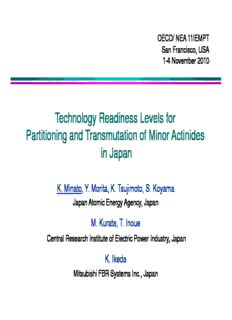
Technology Readiness Levels for Partitioning and Transmutation of Minor Actinides in Japan PDF
Preview Technology Readiness Levels for Partitioning and Transmutation of Minor Actinides in Japan
OECD/ NEA 11IEMPT San Francisco, USA 1-4 November 2010 Technology Readiness Levels for Partitioning and Transmutation of Minor Actinides in Japan K. Minato, Y. Morita, K. Tsujimoto, S. Koyama Japan Atomic Energy Agency, Japan M. Kurata, T. Inoue Central Research Institute of Electric Power Industry, Japan K. Ikeda Mitsubishi FBR Systems Inc., Japan Outline Background / Objectives (cid:122) Technology Readiness Levels (TRL) (cid:122) » What is TRL? » Why use TRL? » Examples of TRL usage TRL for P&T Technology in Japan (cid:122) » MA transmutation systems » MA partitioning processes » MA-bearing fuels Technology pathway discussion with TRL (cid:122) Summary (cid:122) 2 Background The second check and review on the P&T technology (cid:122) » made by the Japan Atomic Energy Commission (JAEC) in 2008-2009, and the final report has been issued in April, 2009 Future research and development plan on the P&T (cid:122) technology should be made The Research Committee on P&T and MA Recycle, (cid:122) Atomic Energy Society of Japan (AESJ) » noticed the usefulness of Technology Readiness Levels (TRL) approach » to support the planning of research and development on P&T technology 3 Objectives Technology Readiness Levels (TRL) approach (cid:122) » was used to provide a quantitative assessment for the maturity of the P&T technology in Japan The present TRL evaluation was (cid:122) » made by the Research Committee on P&T and MA Recycle, AESJ » independent of the Fast Reactor Cycle System Technology Development Project (FaCT Project) in Japan The main objective of the present TRL evaluation is (cid:122) » Not to provide absolute quantitative values of TRL » But to discuss how to conduct the research and development of the P&T technology 4 What is TRL? TRL is a systematic metric/measurement system that (cid:122) supports assessments of the maturity of a particular technology » From a new concept that is viable based on first principles assessment » To full maturity of long-term routine operations of commercial plant » The intermediate steps are defined based on the logical progression of the research and development towards demonstration and deployment 5 TRL for NASA Space Activities System Test, Launch The TRL approach has been (cid:122) & Operations used on-and-off in NASA* System/Subsystem Development space technology planning for many years Technology Demonstration The technology maturation (cid:122) process model for NASA Technology Development space activities Research to Prove » Definition of 9 levels Feasibility – from basic principles at TRL 1 Basic Technology – to operations at TRL 9 Research » The exit criteria at each TRL level John C. Mankins, NASA White Paper “Technology * National Aeronautics and Space Administration Readiness Levels” April 6, 1995. 6 Why use TRL? TRL approach provides (cid:122) » a relative measure of where the technology maturity is compared to the end objective of large-scale deployment TRL is used as (cid:122) » a program management tool – a common understanding of science and technology exit criteria – a consistent comparison of maturity between different types of technology – a communication tool between technologists and managers 7 TRL Evaluation in GNEP TRL Category Generic Description TRL evaluation for (cid:122) Actual facility proven through successful » Advanced recycling 9 mission operations reactor Proof of Prototype facility completed and qualified 8 » LWR spent fuel Performance through test and demonstration processing System prototype demonstration in 7 prototypic environment » Waste form System/subsystem model or prototype development 6 demonstration in relevant environment » Fast reactor spent Proof of Component and/or breadboad validation 5 fuel processing Principle in a relevant environment » Fuel fabrication and Component and/or bench-scale validation 4 in a laboratory environment performance Analytical and experimental demonstration TRL definitions used 3 (cid:122) of critical function and/or proof of concept in GNEP Concept Technology concepts and/or applications 2 Development formulated Global Nuclear Energy Partnership technical Integration Office, GNEP-TECH-TR-PP- 1 Basic principles observed and formulated 2007-00020, July 25, 2007. 8 TRL for P&T Technology in Japan TRL definitions (cid:122) » Based on the TRL definitions used in GNEP Technology included in the present TRL evaluation (cid:122) » Developed in Japan » Developed as international collaboration including Japan TRL evaluation for (cid:122) » MA transmutation systems – MA-loaded core of fast reactor – Accelerator driven system » MA recycling technology – MA partitioning processes (aqueous, pyro) – MA-bearing fuels (oxide, metal, nitride) 9 TRL for MA-loaded Core of FR (1/2) TRL Definitions TRL Category Description 9 Proof of Actual facility proven through successful mission operations : Performance : 6 Nuclear design for MA-loaded core of prototype reactor Critical experiment with MA Proof of 5 Nuclear design for MA-loaded core of experimental reactor Principle MA sample irradiation 4 Nuclear calculation code validation MA nuclear data evaluation 3 Nuclear calculation code development Concept 2 Development MA nuclear data measurement 1 Basic principles observed and formulated 10
Description: